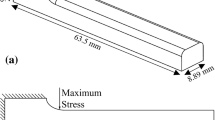Abstract
In an effort to better understand the impact of material degradation on the fatigue life of mining wheels made of a high-strength low alloy carbon steel (Q345), this study seeks to evaluate the effect of surface corrosion on the high-cycle fatigue behavior of the Q345 alloy. The fatigue behavior of the polished and corroded alloy was investigated. Following exposure to a 3.5 wt.% NaCl saltwater solution, polished and corroded fatigue specimens were tested using an R.R. Moore rotating-bending fatigue apparatus. Microstructural analyses via both optical microscopy and scanning electron microscopy (SEM) revealed that one major phase, α-iron phase, ferrite, and one minor phase, colony pearlite, existed in the extracted Q345 alloy. The results of the fatigue testing showed that the polished and corroded specimens had an endurance strength of approximately 295 and 222 MPa, respectively, at 5,000,000 cycles. The corroded surface condition resulted in a decrease in the fatigue strength of the Q345 alloy by 24.6%. Scanning electron microscope fractography indicated that failure modes for polished and corroded fatigue specimens were consistent in the high-cycle low loading fatigue regime. Conversely, SEM fractography of low-cycle high-loading fatigue specimens found considerable differences in fracture surfaces between the corroded and polished fatigue specimens.












Similar content being viewed by others
References
Department of Consumer and Employment Protection, Safety and Health Alert; 13/97 Split Ring Wheel Fatality, Government of Western Australia, Perth, 1997
The National Institute for Occupational Safety and Health Fatality, Mechanic Dies While Changing a Tire Mounted on a Multi-piece Split Rim Wheel—Massachusetts. Assessment and Control Evaluation (FACE) Program, Massachusetts Case Report: 07-MA-058 (2007).
Mines and Aggregates Safety and Health Association, Multi-Piece Rims Leader Guide, Workplace Safety North, Ontario, 2000
Occupational Health and Safety, Hazard Alert; Truck Tire Explosions Claim Two More Lives, Saskatchewan Ministry of Labour Relations and Workplace Safety, Saskatchewan, 2004
Occupational Health and Safety, Hazard Alert; Tire Mount/Demount of Heavy Vehicles, Saskatchewan Ministry of Labour Relations and Workplace Safety, Saskatchewan, 1999
The National Institute for Occupational Safety and Health, Worker Struck By Multi-Piece Rim During Wheel Installation. Fatality Assessment and Control Evaluation (FACE) Program, Alaska Case Report: 03AK006 (2003).
The National Institute for Occupational Safety and Health, Worker Killed While Inflating a Tire Mounted on a Multi-Piece Rim—Massachusetts. FACE (Fatality Investigation and Control Evaluation) Facts, vol. 7, no. 2 (2004).
Y. Zhang and C. Fleek, Metallurgical Failure Analysis of Cracked Wheel Rim, Bodycote Materials Testing Canada Inc., Cambridge, 2008
ASTM A572, Standard Specification for High-Strength Low-Alloy Columbium-Vanadium Structural Steel, ASTM International, West Conshohocken, 2013
Y. Liu and S. Mahadevan, Stochastic Fatigue Damage Modeling Under Variable Amplitude Loading, Int. J. Fatigue, 2007, 29, p 1149–1161
J.X. Liu, S.H. Chen, J. Liu, W.L. Zhang, and X. Chen, Evaluation of Anti-Weathering Performance of Different Construction Steels by In-Door Cyclic Corrosion Tests, J. Iron. Steel Res. Int., 2007, 14(5), p 296–300
X. Zhang, A. Guo, S. Yang, X. Wang, Y. Zhao, Y. Tian, D. Zou, and X. He, Study on the Microstructure, Mechanical Properties and Corrosion Resistance of a Novel HSLA Steel, Kang T’ieh/Iron and Steel (Peking), 2005, 40, p 417–421
Y. Wu, B. Cao, and Z. Fang, SCC Susceptivility of Steel 16Mn in Nitrate Solution and Its Mechanism, J. Univ. Sci. Technol. Beijing, 2002, 9(1), p 31–35
G. Singh, A Survey of Corrosivity of Underground Mine Waters from Indian Coal Mines, Int. J. Mine Water, 1986, 5(1), p 21–32
A. Higginson and R.T. White, A Preliminary Survey of the Corrosivity of Water in South African Gold Mines, J. South Afr. Inst. Min. Metall., 1983, 83(6), p 133–141
ASTM E466-07, Standard Practice for Conducting Force Controlled Constant Amplitude Axial Fatigue Tests of Metallic Materials, ASTM International, West Conshohocken, 2007
ASTM Standard G31, Laboratory Immersion Corrosion Testing of Metals, ASTM International, West Conshohocken, 2012
T.J. Collins, ImageJ for Microscopy, Biotechniques, 2007, 43(1), p S25–S30
Z. Li, A. Tonkovich, S. DiCecco, W. Altenhof, H. Hu, and R. Banting, Development and Validation of a FE Model of a Mining Vehicle Tyre, Int. J. Veh. Des., 2014, 65(2/3), p 176–201
R. Budynas, K. Nisbett (Eds.), Fatigue Failure Resulting from Variable Loading, Shigley’s Mechanical Engineering Design, McGraw-Hill, New York, 2010, p 257–345
ASTM Standard E739, Standard Practice for Statistical Analysis of Linear or Linearized Stress-Life (S-N) and Strain-Life (e-N) Fatigue Data, ASTM International, West Conshohocken, 2010
D.C. Montgomery and G.C. Runger, Applied Statistics and Probability for Engineers, 5th ed., Wiley, New York, 2011
B.C. Reed, Linear Least-Squares Fits with Errors in Both Coordinates, Am. J. Phys., 1989, 7(57), p 642–646
H.J. Sutherland, P.S. Veers, The Development of Confidence Limits For Fatigue Strength Data, in 2000 ASME Wind Energy Symposium, Albuquerque, New Mexico, USA, 2000.
P.C. Gope, Scatter Analysis of Fatigue Life and Prediction of S-N Curve, J. Fail. Anal. Prev., 2012, 12, p 507–517
Acknowledgments
The financial support from Work Safety Insurance Board (WSIB) of Ontario, Canada is gratefully acknowledged. Additionally, the in-kind support from GoldCorp’s Musselwhite Mine is also acknowledged. Mr. Sante DiCecco would also like to acknowledge the financial support from the Natural Sciences and Engineering Research Council of Canada (NSERC).
Author information
Authors and Affiliations
Corresponding author
Rights and permissions
About this article
Cite this article
Dicecco, S., Altenhof, W., Hu, H. et al. High-Cycle Fatigue of High-Strength Low Alloy Steel Q345 Subjected to Immersion Corrosion for Mining Wheel Applications. J. of Materi Eng and Perform 26, 1758–1768 (2017). https://doi.org/10.1007/s11665-017-2565-2
Received:
Revised:
Published:
Issue Date:
DOI: https://doi.org/10.1007/s11665-017-2565-2




